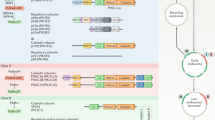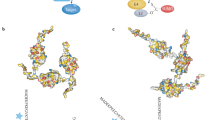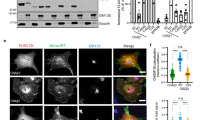Abstract
Class IA phosphatidylinositol 3-kinases (PI3Ks) are composed of p110 catalytic and p85 regulatory subunits. How regulatory subunits modulate PI3K activity remains only partially understood. Here we identified SUMO (small ubiquitin-related modifier) as a new player modulating this regulation. We demonstrate that both p85β and p85α are conjugated to SUMO1 and SUMO2. We identified two lysine residues located at the inter-SH2 domain on p85β, a critical region required for inhibition of p110, as being required for SUMO conjugation. A SUMOylation-defective mutant p85β shows higher activation of the PI3K pathway, and increased cell migration and transformation. Moreover, the cancer-related KS459del mutant in p85α was less efficiently SUMOylated compared with the wild-type protein. Finally, our results show that SUMO modulates p85 tyrosine phosphorylation, a modification correlating with PI3K pathway activation. Thus, SUMO reduces the levels of tyrosine-phosphorylated-p85 while loss of SUMOylation results in increased tyrosine phosphorylation of p85. In summary, we identify SUMO as a new important player in the regulation of the PI3K pathway through modulation of p85.
This is a preview of subscription content, access via your institution
Access options
Subscribe to this journal
Receive 50 print issues and online access
$259.00 per year
only $5.18 per issue
Buy this article
- Purchase on Springer Link
- Instant access to full article PDF
Prices may be subject to local taxes which are calculated during checkout





Similar content being viewed by others
References
Vanhaesebroeck B, Waterfield MD . Signaling by distinct classes of phosphoinositide 3-kinases. Exp Cell Res 1999; 253: 239–254.
Cantley LC . The phosphoinositide 3-kinase pathway. Science 2002; 296: 1655–1657.
Franke TF, Hornik CP, Segev L, Shostak GA, Sugimoto C . PI3K/Akt and apoptosis: size matters. Oncogene 2003; 22: 8983–8998.
Yu J, Zhang Y, McIlroy J, Rordorf-Nikolic T, Orr GA, Backer JM . Regulation of the p85/p110 phosphatidylinositol 3'-kinase: stabilization and inhibition of the p110alpha catalytic subunit by the p85 regulatory subunit. Mol Cell Biol 1998; 18: 1379–1387.
Skolnik EY, Margolis B, Mohammadi M, Lowenstein E, Fischer R, Drepps A et al. Cloning of PI3 kinase-associated p85 utilizing a novel method for expression/cloning of target proteins for receptor tyrosine kinases. Cell 1991; 65: 83–90.
Stoyanov B, Volinia S, Hanck T, Rubio I, Loubtchenkov M, Malek D et al. Cloning and characterization of a G protein-activated human phosphoinositide-3 kinase. Science 1995; 269: 690–693.
Hale BG, Jackson D, Chen YH, Lamb RA, Randall RE . Influenza A virus NS1 protein binds p85beta and activates phosphatidylinositol-3-kinase signaling. Proc Natl Acad Sci USA 2006; 103: 14194–14199.
Street A, Macdonald A, Crowder K, Harris M . The hepatitis C virus NS5A protein activates a phosphoinositide 3-kinase-dependent survival signaling cascade. J Biol Chem 2004; 279: 12232–12241.
Rordorf-Nikolic T, Van Horn DJ, Chen D, White MF, Backer JM . Regulation of phosphatidylinositol 3'-kinase by tyrosyl phosphoproteins. Full activation requires occupancy of both SH2 domains in the 85-kDa regulatory subunit. J Biol Chem 1995; 270: 3662–3666.
Cortes I, Sanchez-Ruiz J, Zuluaga S, Calvanese V, Marqués M, Hernández C et al. p85beta phosphoinositide 3-kinase subunit regulates tumor progression. Proc Natl Acad Sci USA 2012; 109: 11318–11323.
Ito Y, Hart JR, Ueno L, Vogt PK . Oncogenic activity of the regulatory subunit p85beta of phosphatidylinositol 3-kinase (PI3K). Proc Natl Acad Sci USA 2014; 111: 16826–16829.
Cheung LW, Hennessy BT, Li J, Yu S, Myers AP, Djordjevic B et al. High frequency of PIK3R1 and PIK3R2 mutations in endometrial cancer elucidates a novel mechanism for regulation of PTEN protein stability. Cancer Discov 2011; 1: 170–185.
Quayle SN, Lee JY, Cheung LW, Ding L, Wiedemeyer R, Dewan RW et al. Somatic mutations of PIK3R1 promote gliomagenesis. PLoS One 2012; 7: e49466.
Sun M, Hillmann P, Hofmann BT, Hart JR, Vogt PK . Cancer-derived mutations in the regulatory subunit p85alpha of phosphoinositide 3-kinase function through the catalytic subunit p110alpha. Proc Natl Acad Sci USA 2010; 107: 15547–15552.
Cuevas BD, Lu Y, Mao M, Zhang J, LaPushin R, Siminovitch K et al. Tyrosine phosphorylation of p85 relieves its inhibitory activity on phosphatidylinositol 3-kinase. J Biol Chem 2001; 276: 27455–27461.
Martinez-Lorenzo MJ, Anel A, Monleon I, Sierra JJ, Piñeiro A, Naval J et al. Tyrosine phosphorylation of the p85 subunit of phosphatidylinositol 3-kinase correlates with high proliferation rates in sublines derived from the Jurkat leukemia. Int J Biochem Cell Biol 2000; 32: 435–445.
Bassi C, Ho J, Srikumar T, Dowling RJO, Gorrini C, Miller SJ et al. Nuclear PTEN controls DNA repair and sensitivity to genotoxic stress. Science 2013; 341: 395–399.
de la Cruz-Herrera CF, Campagna M, Lang V, González-Santamaría J, Marcos-Villar L, Rodríguez MS et al. SUMOylation regulates AKT1 activity. Oncogene 2015; 34: 1442–1450.
Gonzalez-Santamaria J, Campagna M, Ortega-Molina A, Marcos-Villar L, de la Cruz-Herrera CF, González D et al. Regulation of the tumor suppressor PTEN by SUMO. Cell Death Dis 2012; 3: e393.
Huang J, Yan J, Zhang J, Zhu S, Wang Y, Shi T et al. SUMO1 modification of PTEN regulates tumorigenesis by controlling its association with the plasma membrane. Nat Commun 2012; 3: 911.
Li R, Wei J, Jiang C, Liu D, Deng L, Zhang K et al. Akt SUMOylation regulates cell proliferation and tumorigenesis. Cancer Res 2013; 73: 5742–5753.
Risso G, Pelisch F, Pozzi B, Mammi P, Blaustein M, Colman-Lerner A et al. Modification of Akt by SUMO conjugation regulates alternative splicing and cell cycle. Cell Cycle 2013; 12: 3165–3174.
Cariaga-Martinez AE, Cortes I, Garcia E, Pérez-García V, Pajares MJ, Idoate MA et al. Phosphoinositide 3-kinase p85beta regulates invadopodium formation. Biol Open 2014; 3: 924–936.
Philp AJ, Campbell IG, Leet C, Vincan E, Rockman SP, Whitehead RH et al. The phosphatidylinositol 3'-kinase p85alpha gene is an oncogene in human ovarian and colon tumors. Cancer Res 2001; 61: 7426–7429.
Shekar SC, Wu H, Fu Z, Yip SC, Nagajyothi, Cahill SM et al. Mechanism of constitutive phosphoinositide 3-kinase activation by oncogenic mutants of the p85 regulatory subunit. J Biol Chem 2005; 280: 27850–27855.
Desterro JM, Rodriguez MS, Hay RT . SUMO-1 modification of IkappaBalpha inhibits NF-kappaB activation. Mol Cell 1998; 2: 233–239.
Vertegaal AC, Andersen JS, Ogg SC, Hay RT, Mann M, Lamond AI . Distinct and overlapping sets of SUMO-1 and SUMO-2 target proteins revealed by quantitative proteomics. Mol Cell Proteomics 2006; 5: 2298–2310.
Campagna M, Herranz D, Garcia MA, Marcos-Villar L, González-Santamaría J, Gallego P et al. SIRT1 stabilizes PML promoting its sumoylation. Cell Death Differ 2011; 18: 72–79.
Marcos-Villar L, Lopitz-Otsoa F, Gallego P, Muñoz-Fontela C, González-Santamaría J, Campagna C et al. Kaposi's sarcoma-associated herpesvirus protein LANA2 disrupts PML oncogenic domains and inhibits PML-mediated transcriptional repression of the survivin gene. J Virol 2009; 83: 8849–8858.
Acknowledgements
We thank Drs Lewis Cantley and Lynda Chin who deposited p85 plasmids at Addgene. Funding at the laboratory of CR is provided by BFU2014-58530. CFC-H is supported by La Caixa fellowship and CONACYT. Work in the laboratory of MC is funded by ISCIII (PI14/00554). The funders had no role in study design, data collection and analysis, decision to publish or preparation of the manuscript.
Author information
Authors and Affiliations
Corresponding author
Ethics declarations
Competing interests
The authors declare no conflict of interest.
Additional information
Supplementary Information accompanies this paper on the Oncogene website
Supplementary information
Rights and permissions
About this article
Cite this article
de la Cruz-Herrera, C., Baz-Martínez, M., Lang, V. et al. Conjugation of SUMO to p85 leads to a novel mechanism of PI3K regulation. Oncogene 35, 2873–2880 (2016). https://doi.org/10.1038/onc.2015.356
Received:
Revised:
Accepted:
Published:
Issue Date:
DOI: https://doi.org/10.1038/onc.2015.356
This article is cited by
-
Crosstalk between circRNAs and the PI3K/AKT signaling pathway in cancer progression
Signal Transduction and Targeted Therapy (2021)
-
SUMOylation modulates the stability and function of PI3K-p110β
Cellular and Molecular Life Sciences (2021)
-
Regulation of Ebola virus VP40 matrix protein by SUMO
Scientific Reports (2016)



